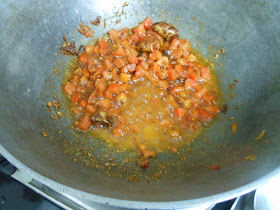We have all learnt about the four basic tastes: sweet, salty, sour and bitter and we also know the different sensitivity of the different parts of the tongues to these tastes.
There are more than these four basic tastes however. The fifth taste that we hear less often of is umami that is the taste of amino acids such monosodium glutamate (ajinomoto), cheese or meats. When I heard about this new taste, I went back and thought about the taste of cheese. Yes, it has a salty edge, but if you think back on it, the particular taste of cheese does not really fit into any of the four basic taste categories.
As we all know tastes interact with each other. A little bit of saltiness brings out sweet taste. If you see we do not use unsalted butter for baking even though it is commonly available. I have seen many sweet baking recipes where Sanjeev Kapoor has added a little pinch of salt to the batter or dough. Sourness brings out saltiness. Have you ever drizzled a dash of vinegar on your chips? Now you know why they get tastier (apart from the fact that they are fried of course!)
The interesting effect of this taste is that it brings out the flavour of all the tastes. This is because it enhances the binding of the taste molecules to their particular receptors on their respective taste buds. Think about it, when we add cheese to a dish, it not only adds its own flavour to the dish, but the taste of other ingredients of the dish comes out better too. Now we know why the (Indian) Chinese food that we eat with MSG tastes good!
And apparently cheese is not only adds flavour to your pizzas and garlic bread and other savoury dishes but can also do it for your sweet dishes. One example of this that comes to my mind is the weird combination (to me) of cheese and jam sandwiches that a lot of people around me really relish and I have been asked to try. Maybe I will try them sometime and see!
So to knowing about the elusive and less heard of umami.
There are more than these four basic tastes however. The fifth taste that we hear less often of is umami that is the taste of amino acids such monosodium glutamate (ajinomoto), cheese or meats. When I heard about this new taste, I went back and thought about the taste of cheese. Yes, it has a salty edge, but if you think back on it, the particular taste of cheese does not really fit into any of the four basic taste categories.
As we all know tastes interact with each other. A little bit of saltiness brings out sweet taste. If you see we do not use unsalted butter for baking even though it is commonly available. I have seen many sweet baking recipes where Sanjeev Kapoor has added a little pinch of salt to the batter or dough. Sourness brings out saltiness. Have you ever drizzled a dash of vinegar on your chips? Now you know why they get tastier (apart from the fact that they are fried of course!)
The interesting effect of this taste is that it brings out the flavour of all the tastes. This is because it enhances the binding of the taste molecules to their particular receptors on their respective taste buds. Think about it, when we add cheese to a dish, it not only adds its own flavour to the dish, but the taste of other ingredients of the dish comes out better too. Now we know why the (Indian) Chinese food that we eat with MSG tastes good!
And apparently cheese is not only adds flavour to your pizzas and garlic bread and other savoury dishes but can also do it for your sweet dishes. One example of this that comes to my mind is the weird combination (to me) of cheese and jam sandwiches that a lot of people around me really relish and I have been asked to try. Maybe I will try them sometime and see!
So to knowing about the elusive and less heard of umami.




























